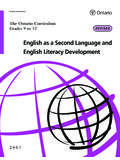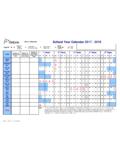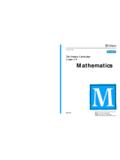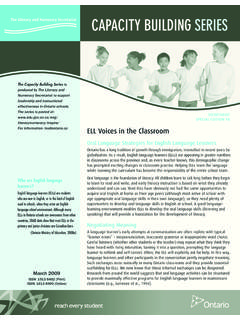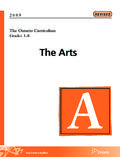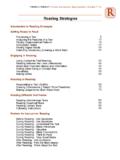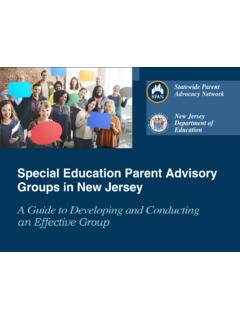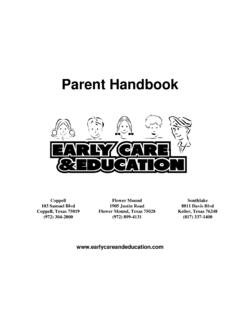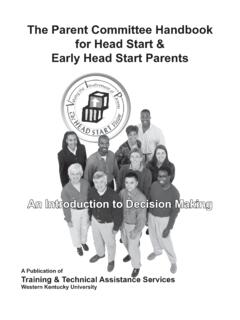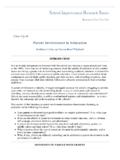Transcription of Doing Mathematics with Your Child - Ministry of Education
1 Doing Mathematics with your ChildKindergarten to Grade 67 = 2 + 5 Doing Mathematics with your Child , Kindergarten to Grade 6 is an update of the Ontario Ministry of Education s Helping your Child Do Mathematics : A Guide for more information for parents at to parents ..2 How can I support my Child s learning? ..2 Why is a belief in our children s ability to learn Mathematics essential? ..3 What are the connections to the curriculum? ..4 Some Fun Family Learning Experiences Numbers are everywhere! ..5 How high? How low? How much? How little? ..15 What s your angle on that? ..20 Over and over again! ..24 What are the chances? ..29 Online Resources .. and Math ..37 The greater the support that families provide for their children s learning and educational progress, the more likely that their children will do well in school and continue on with their Education . Karen Mapp and Anne Henderson, 2002 A New Wave of Evidence: The Impact of School, Family, and Community Connections on Student AchievementDoing Mathematics with your Child , Kindergarten to Grade 6: A Parent Guide1 NOTE TO PARENTSHow can I support my Child s learning?
2 You are an important partner in your Child s Mathematics you find ways to engage your Child in thinking and talking about Mathematics , you are providing an important key for unlocking his or her future , critical thinking, problem solving, reasoning ability and the ability to communicate mathematically are essential skills. These processes are the foundation of Mathematics instruction in Ontario schools. They are brought into play as you engage your Child in the activities suggested in this learning together!Helping students achieve excellence in Mathematics is part of Achieving Excellence: A Renewed Vision for Education in Ontario. Learn more at Mathematics with your Child , Kindergarten to Grade 6: A Parent Guide2 Top Tips for parents Build strong, positive attitudes about math. When children feel positively engaged and successful, they are more likely to stick with an activity or a problem to find a solution.
3 Begin with activities that meet your Child s level of mathematical understanding. Early success in solving problems will build your Child s confidence. Gradually move to activities that provide more challenge for your Child . If you and your Child are more comfortable in a language other than English, use it. your Child will understand concepts better in the language that he or she knows note: In this guide, the word parent refers to parents , guardians, caregivers and other family members who help children learn TO PARENTSHow is Ontario s math curriculum helping students learn the essentials? Ontario s Mathematics curriculum reflects current research and is similar to that of other high-performing jurisdictions. The curriculum provides instruction to build mathematical concepts, procedures and skills. It also provides a balance of problem solving and practice. These types of activities help build the mathematical knowledge and skills our students need for a successful and rewarding participation in students understand and apply Mathematics knowledge and skills is a collective responsibility of parents , teachers and principals.
4 Students need to learn Mathematics in a way that will serve them throughout their lives. Understanding Mathematics can provide our students with many job and career opportunities. This is why students need to know why Mathematics works the way it does, how to use it with confidence and competence when solving problems. Understanding Mathematics enables us to: Solve problems and make sound decisions Perform calculations with ease Explain how we solved a problem and why we made a particular decision Use technology such as calculators and computer applications to help solve problems Understand patterns and trends so that we can make predictions Manage our time and money Handle everyday situations that involve numbers Before your Child can learn Mathematics , he or she needs to believe in his or her ability to do so. That s where you come in. You can be your Child s first role model for learning.
5 When you engage with your Child in a supportive, relaxed atmosphere, your Child will enjoy exploring the world of Mathematics . 7 = 2 + 53 Doing Mathematics with your Child , Kindergarten to Grade 6: A Parent GuideNOTE TO PARENTSWhat are the connections to the curriculum?The activities in this guide were selected to help your Child see math in everyday activities . They also build on children s love of games. And they support the learning expectations in the Ontario Mathematics that you don t have to do all the activities in this guide to support your Child s math success. And although many activities have been included, they don t cover everything in the curriculum. The guide offers a sampling of the kinds of activities that you can do with your Child to encourage him or her to start thinking and talking mathematically!You will recognize the names of the five strands of the Ontario Mathematics curriculum from reading your Child s report Five StrandsDoing Mathematics with your Child , Kindergarten to Grade 6: A Parent Guide4 Number Sense and NumerationMeasurementGeometry and Spatial SensePatterning and AlgebraData Management and ProbabilityLearning to Think (and Talk) Like a MathematicianThe Ontario Mathematics curriculum emphasizes seven processes that are essential for learning Mathematics : Problem solving Reasoning and proving Reflecting Connecting Selecting tools and computational strategies Representing CommunicatingIn each grade, a set of mathematical process expectations describes how children actively learn and apply mathematical Mathematics curriculum: Mathematics with your Child , Kindergarten to Grade 6: A Parent Guide5 NUMBERS ARE EVERYWHERE!
6 Kindergarten to Grade 3 You will find activities that support Number Sense and Numeration on the orange pages. This is the strand in the Ontario Mathematics curriculum that is about understanding how numbers work and how they relate to each other. It also covers the basic operations: addition, subtraction, multiplication and division. Number Sense and Numeration provides the foundation for mathematical are everywhere!How high? How low? How much? How little?What s your angle on that?Over and over again!What are the chances?NUMBERS ARE EVERYWHERE!So Many Things to Count! Doing Mathematics with your Child , Kindergarten to Grade 6: A Parent Guide6 BenefitsWhen children first begin to count, they learn important mathematical ideas: One-to-one correspondence (one number for one object) Stable order (we count 1, 2, 3, 4, .. not 1, 2, 7, 5, ..) Cardinality (the last number counted tells how many)When children are learning to count, they like to touch, point to and move objects as they say the number aloud so encourage them to!
7 Tip! Have your Child count toys, kitchen utensils, items of clothing as they come out of the dryer, collections (such as stickers, buttons or rocks) and any other items your Child shows interest in counting. Mix it up! Have your Child count a set of objects but start at different places in the set (for example, start counting in the middle of the set rather than at the beginning). This helps to develop the idea that the counting of objects can begin with any object in a set and the total will still be the same. Sing counting songs and use counting in meaningful ways in games, such as Hide-and-Seek. Counting games, rhymes and songs exist in every culture. Some counting songs and rhymes help children to count forward and backward as well. Have your Child skip count (counting by twos, fives or tens) to count larger groups of items quickly. Use such objects as blocks, pasta pieces, toothpicks or Mathematics with your Child , Kindergarten to Grade 6: A Parent Guide7 NUMBER SENSE AND NUMERATIONK indergarten to Grade 3 How Many?
8 BenefitsAs children count, they learn to connect quantities (such as five buttons) with their number names (such as the word five) and symbols (such as 5). Develop your Child s awareness of the symbols used to represent numbers by making it a game. Look for number symbols in your home and neighbourhood: on the television remote, on the microwave, on the telephone keypad, in flyers and media, on signs and on team sweaters. Play a number version of I Spy. For example, I spy something that has the number five on it, or I spy something in this room that there are three of. Ask for your Child s help to count items in your home. I wonder how many chairs we have around the table? In this room? In the house? Count windows, light switches, lamps or beds. You might record how many by using a combination of numbers and Mathematics with your Child , Kindergarten to Grade 6: A Parent Guide8 NUMBERS ARE EVERYWHERE!
9 Solve Everyday ProblemsTip!Encourage your Child to talk about and show a math problem in a way that makes sense to her or him for example, your Child may act it out, use the actual materials, draw it or count on his or her fingers!Involve your Child in using numbers to solve problems and make everyday decisions. You might ask the following: We need six tomatoes to make our sauce for dinner, and we have only two. How many more do we need to buy? You have two pillows in your room and your sister has two pillows in her room. How many pillowcases do I need to wash? Two guests are coming to eat dinner with us. How many plates will we need? How many utensils? More challenging situations might involve adding or subtracting larger numbers, or situations in which your Child has to add or subtract more than once to solve the SENSE AND NUMERATIOND oing Mathematics with your Child , Kindergarten to Grade 6: A Parent Guide9 Kindergarten to Grade 3 Adding and Subtracting Made FunBenefitsBy playing these games, your Child will learn there is no right way to add and subtract mathematicians use a variety of !
10 Encourage your Child to use a strategy that makes sense to him or her for example, a counting-on strategy might help your Child keep track of the score in a game, starting with the larger number (such as 12) and then counting on the remaining quantity (such as 13, 14, 15, ..).You can make up games that involve adding and subtracting numbers by using number cubes and number cards. Have your Child help you make four or more sets of number cards. Each card will have a number from one to ten on one side of it. Here are some games to try: Higher Number. Shuffle or mix up the cards and then leave them face down in a pile. Each player takes two cards and adds the numbers. The player with the higher sum gets the other player s cards. Players continue to take and add up two cards at a time until no cards are left. The player with more cards is the winner. You can play the same game with subtraction, but it would be called Lower Number.


